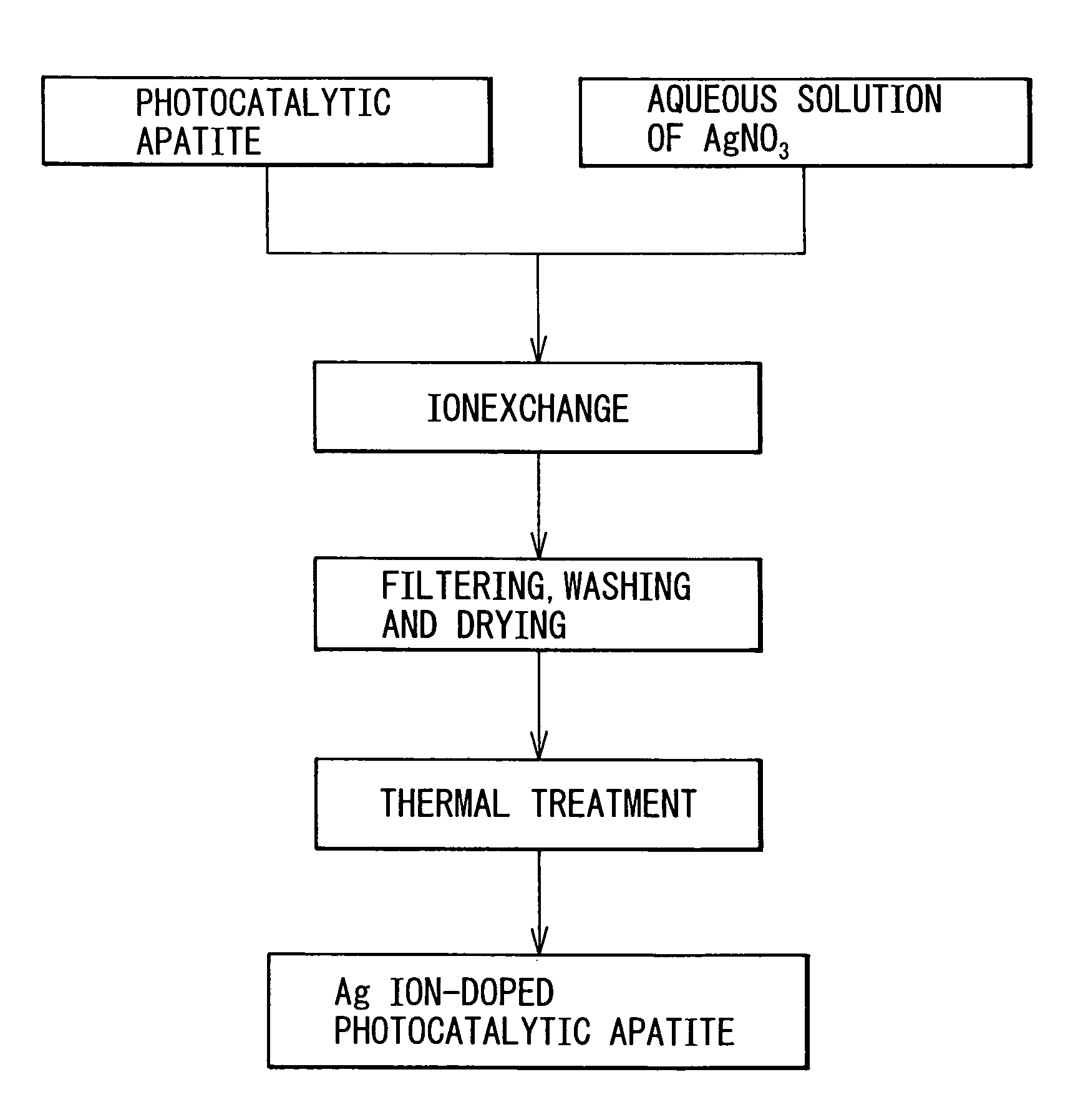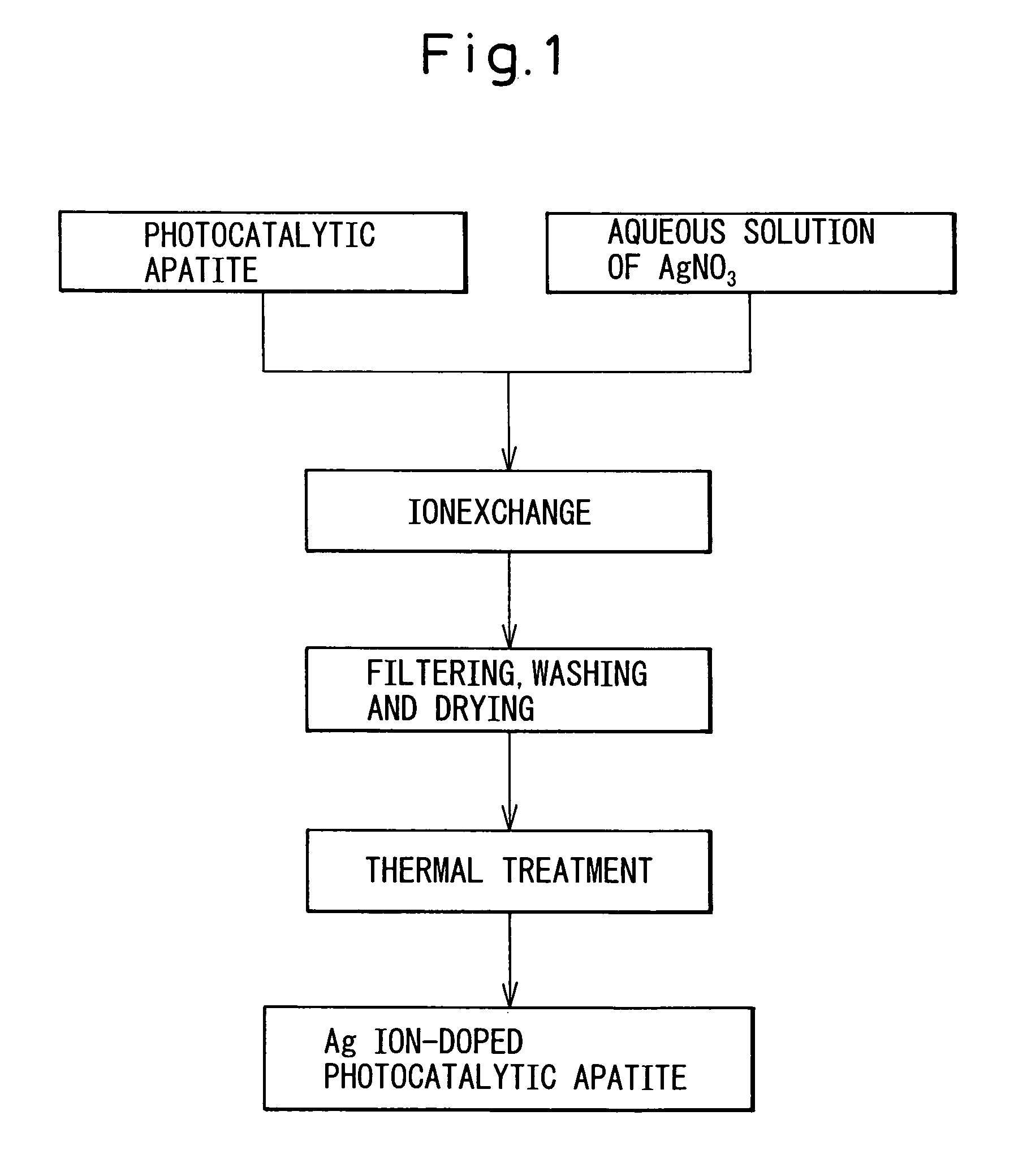Photocatalytic apatite composition as well as production method and article thereof
a photocatalytic apatite and composition technology, applied in physical/chemical process catalysts, metal/metal-oxide/metal-hydroxide catalysts, separation processes, etc., can solve the problems of titanium oxide and photocatalytic apatite having a common problem, low decomposition efficiency, and no antimicrobial ability of titanium oxide, etc., to achieve excellent decomposition and adsorption properties, easy and simple production, and excellent antimicrobial properties
- Summary
- Abstract
- Description
- Claims
- Application Information
AI Technical Summary
Benefits of technology
Problems solved by technology
Method used
Image
Examples
example 1
[0069]In this example, a silver ion-doped photocatalytic apatite was prepared by the dipping method.
[0070]First, 3 g of a commercially available photocatalytic apatite (Ti—CaHAP, “PHOTOHAP PCAP-100”, trade name, produced by Taihei Chemical Industrial Co., Ltd., white powder, average particle diameter: from 3 to 8 μm) was added to 300 milliliter (mL) of an aqueous silver nitrate solution (1×10−5 mol) and stirred by a magnetic stirrer for 5 minutes, and the produced precipitate was filtered, washed with pure water, thoroughly dried in an oven at 100° C., and then thermally treated in an electric furnace at 650° C. for 1 hours. The obtained product was analyzed and confirmed to be a silver ion-doped photocatalytic apatite (Ti—CaHAP).
example 2
[0071]In this example, a silver ion-doped photocatalytic apatite was prepared by the coprecipitation method.
[0072]First, 1 L of pure water subjected to decarbonation was prepared, and 0.1 mol of calcium nitrate, titanium sulfate in a different amount of giving Ti / (Ti+Ca) of 0.1 (molar ratio), 0.06 mol of phosphoric acid and 300 mL of an aqueous silver nitrate solution (1×10−5 mol) were added to the pure water in a nitrogen atmosphere. The obtained mixture was carefully mixed, and the pH value of the mixture was then adjusted to 9.0 by adding 15 mol / L of aqueous ammonia. Subsequently, the obtained suspension was transferred to a Teflon (registered trademark) bottle and ripened at 100° C. over 6 hours. The suspension in which a precipitate was produced was filtered, and the precipitate collected by filtration was washed with 5 L of pure water and dried in a dry oven at 70° C. for 12 hours. The obtained product was analyzed and confirmed to be a silver ion-doped photocatalytic apatite ...
PUM
| Property | Measurement | Unit |
|---|---|---|
| temperature | aaaaa | aaaaa |
| temperature | aaaaa | aaaaa |
| particle diameter | aaaaa | aaaaa |
Abstract
Description
Claims
Application Information
 Login to View More
Login to View More - R&D
- Intellectual Property
- Life Sciences
- Materials
- Tech Scout
- Unparalleled Data Quality
- Higher Quality Content
- 60% Fewer Hallucinations
Browse by: Latest US Patents, China's latest patents, Technical Efficacy Thesaurus, Application Domain, Technology Topic, Popular Technical Reports.
© 2025 PatSnap. All rights reserved.Legal|Privacy policy|Modern Slavery Act Transparency Statement|Sitemap|About US| Contact US: help@patsnap.com



